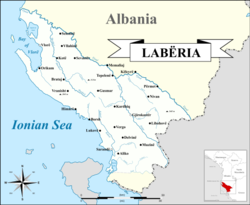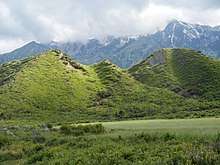Labëria
Labëria is a historic region that is roughly situated in southwestern Albania. Its inhabitants are known as Labs (referred to as Albanian: Lab, pl. Lebër, also dial. sing. Lap; Greek: Λιάπηδες, Liapides) and its boundaries reach from Vlorë to Himara in the south, to the Greek border near Sarandë, incorporating the Kurvelesh region of Gjirokastër District and extending east to the city of Tepelenë.
Labëria Labër | |
|---|---|
 Map of Labëria, based on the more expansive version (see Labëria#Extent) | |
| Biggest city | Vlorë |
| Time zone | UTC+1 (CET) |
| • Summer (DST) | UTC+2 (CEST) |
| ISO 3166 code | AL |
Extent
In its most extensive definition, Labëria may be used to include everything from Mallakastra and the Vjosa river down to Saranda, and in its (somewhat more common) most specific definition, it may refer only to Himara, Tepelena and Kurvelesh. In the more extensive definition, in addition to these three regions, other regions included are Vlore and its surroundings south of the Vjosa river, Lunxhëria, Mallakastra, Gjirokastër and its surroundings, Delvinë and its surroundings, Pogon, Dropull, Saranda and sometimes ( very rarely) Këlcyra and Zagori. Bordering regions include Pogon, Myzeqe, Chamëria, Dangëllia and Dishnica (as well as the border with Greece).

Culture
Labëria is culturally distinguishable from the rest of Albania in its traditions and folklore. The Labs were warlike pastoral people who lived mainly in the mountains of Kurvelesh, Progonat and Vlorë during the Byzantine period and the Ottoman invasion of Albania. However, due to mass migrations to urban areas following World War II, the population is now concentrated in the cities of Vlorë, Tepelenë, Gjirokastër and Sarandë.
Pleqërishte is a genre of Albanian iso-polyphony primarily found in Labëria
Music of Labs is polyphonic, more soft and lyrical than rugged single voiced music of Ghegs dedicated to heroism.[1] Labs developed a codex of customary laws, Kanun of Labëria (Albanian: Kanuni i Labërisë or Albanian: Kanuni i Papa Zhulit).[2][3] This set of traditional unwritten laws which survived Byzantine and Ottoman periods in the isolated and inaccessible territories of southwest Albania.[4]
During regime of Enver Hoxha the Labs, Ghegs and Tosks were forbidden to emphasize their identity.[5]
History
Historically the Labs were followers of the Greek Orthodox Church but many converted to Islam during Ottomon rule, with the bulk of conversion occurring in the 18th century. Conversions were especially intense during years of conflict between Orthodox Russia and the Ottoman Empire, during which some pressure was applied on Orthodox Christians by Ottoman rulers, including even low-scale forced conversion of villages, contradicting the official Ottoman tolerance for Christians.[6] Additional reasons for conversion included discrimination and exploitation of Christians by Ottoman rulers, the previous patterns of conversion between different Christian sects and the diverse pre-Ottoman distribution of Christian faiths in the region (including Orthodoxy, Catholicism, Bogomilism, and even Arianism), the poll tax which only Christians had to pay, the poverty of the church, the mass illiteracy of priests and the fact that the language of worship was not the Albanian vernacular.[6][7] Tradition holds that a mass conversion of Labs occurred during a famine in which the bishops of Himara and Delvina refused to let the Labs break fast and drink milk.[8]
Many Labs were recruited by the Ottoman Jannissary corps due to their warlike nature and the Ottomans' initial preference for recruiting Albanians after their invasion of the Balkans. After the disbandment of the Jannissary corps by Sultan Mahmud II in 1826, the Sufi branch of the Bektashi Order, a core Janissary institution, was also disbanded, and its followers executed or exiled to Southern Albania. As a result, the majority of the Labs today belong to the Bektashi faith with Orthodox Christians concentrated in the Himara coastal region as well as a few pockets throughout Vlorë district and the southern and eastern parts of the region, around Gjirokastër, Delvine and Sarande.
Ali Pasha of Tepelena or of Yanina (Ioannina), surnamed Aslan, "the Lion", or the "Lion of Yannina" (1740–1822), was born in this region. He ruled the western part of Rumelia, the Ottoman Empire's European territory which was also called Pashalik of Yanina. His court was in Ioannina. Ali had three sons: Ahmet Muhtar Pasha (served in the 1809 war against the Russians), Veli Pasha of Morea and Salih Pasha of Vlorë. Ali Pasha of Tepelena died fighting on February 5, 1822, at the age of 82.
Language
The dialect associated with Labëria is the Lab dialect, which is particular to the region. The dialect mixes innovative and archaic features, and is closely related to the Arbëresh spoken by the old Albanian diaspora in Italy, the Arvanitika of Arvanites in Greece, and Cham Albanian.
The Himariote dialect of Greek is also spoken in the region of Himara, which is often considered part of Laberia, and other Greek dialects are spoken in the southern extremes of the region as well as in the villages of Nartë and Zvernec. Aromanian and Roma minorities that are present in some places may also speak their ancestral languages.
Religion
At the end of medieval period the semi nomadic Orthodox Christian Labs converted to Islam. One of the reasons was that Christian bishops refused to allow them to consume milk during fast days.[9]
See also
References
- Broughton, Simon (1994). World Music: The Rough Guide. Rough Guides. p. 2. ISBN 978-1-85828-017-2.
Gheg music is rugged, heroic and single voiced while Tosk and Lab music is softer, more lyrical and polyphonic.
- Boskovic, Aleksandar; Hann, Chris (31 December 2013). The Anthropological Field on the Margins of Europe, 1945-1991. LIT Verlag Münster. p. 180. ISBN 978-3-643-90507-9.
- Waal, Clarissa de (17 September 2005). Albania Today: A Portrait of Post-Communist Turbulence. I.B.Tauris. p. 254. ISBN 978-1-85043-859-5.
- Murzaku, Ines Angjeli (2009). Returning Home to Rome: The Basilian Monks of Grottaferrata in Albania. Analekta Kryptoferris. p. 59. ISBN 978-88-89345-04-7.
- Mackenzie, Sir Compton; Stone, Christopher (1999). The Gramophone. C. Mackenzie. p. 98.
...the Tosks, Labs and Gegs - all minorities which under Enver Hoxha had been forbidden to flaunt their identity.
- Giakoumis, Kosta. The Orthodox Church in Albania during Ottoman Rule. Page 8.
- Skendi, "Religion in Ottoman Albania", p319-320
- Aravantinos, Perigraphi tis Epeiros, pp444-445
- Schmitt, Oliver Jens (2010). Religion und Kultur im albanischsprachigen Südosteuropa. Peter Lang. p. 88. ISBN 978-3-631-60295-9.